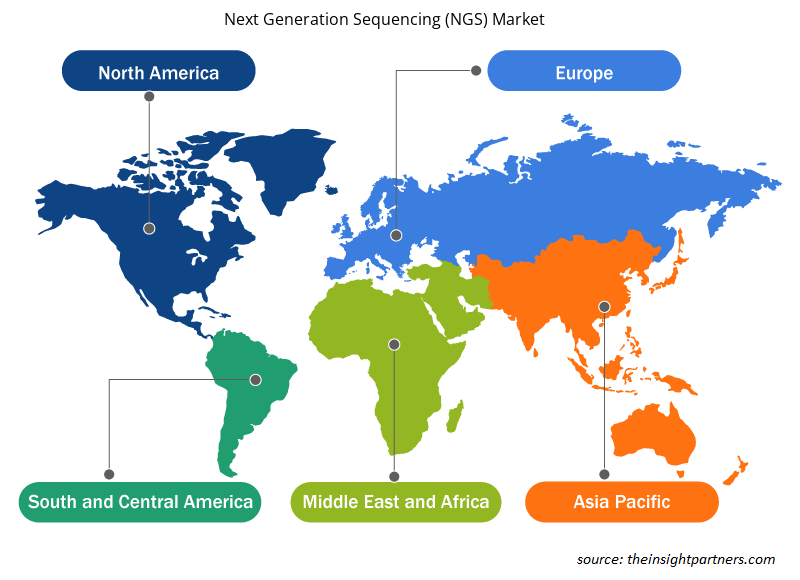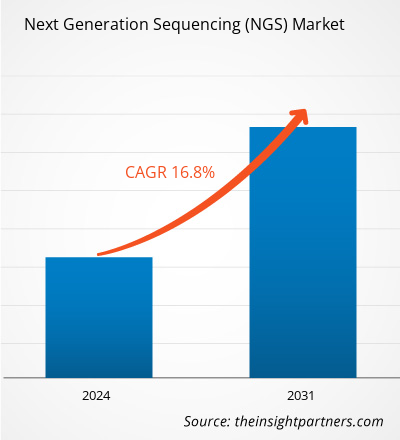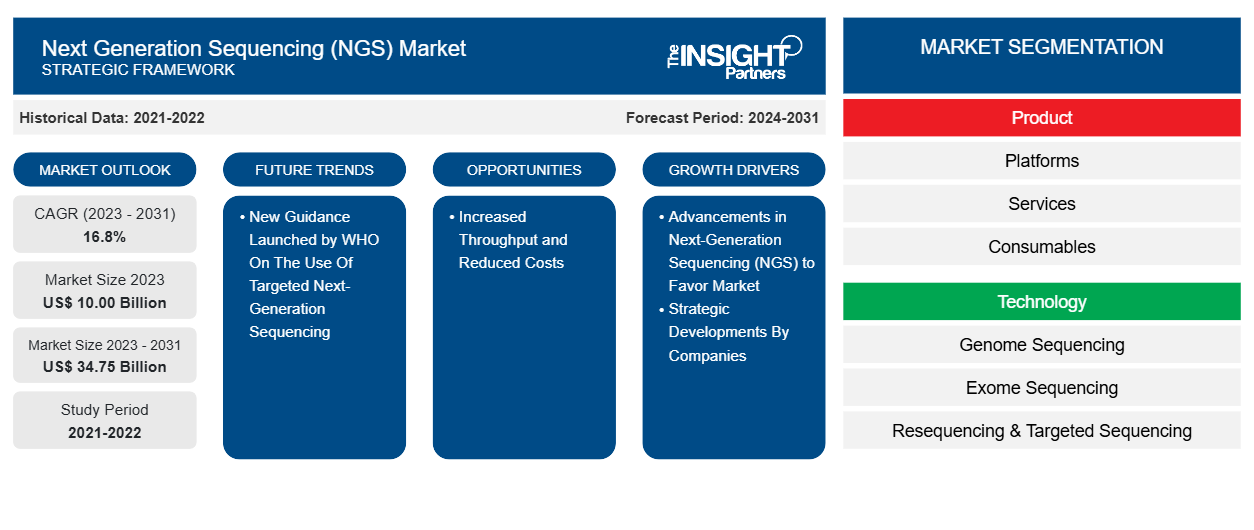من المتوقع أن يصل حجم سوق التسلسل الجيني للجيل التالي (NGS) إلى 34.75 مليار دولار أمريكي بحلول عام 2031 من 10.00 مليار دولار أمريكي في عام 2023.ومن المتوقع أن يسجل السوق معدل نمو سنوي مركب بنسبة 16.8% خلال الفترة 2023-2031. ومن المرجح أن تظل زيادة الإنتاج وخفض التكاليف من الاتجاهات الرئيسية في السوق.
تحليل سوق تسلسل الجيل التالي (NGS)
وفقًا لمراكز السيطرة على الأمراض والوقاية منها، تحدث 41 مليون حالة وفاة سنويًا بسبب الأمراض غير المعدية، وهو ما يعادل 74% من جميع الوفيات على مستوى العالم. ومن بين جميع الوفيات الناجمة عن الأمراض غير المعدية، تحدث 77% في البلدان المنخفضة والمتوسطة الدخل. وتتسبب أمراض القلب والأوعية الدموية في وفاة 17.9 مليون شخص من بين معظم الوفيات الناجمة عن الأمراض غير المعدية، تليها السرطانات (9.3 مليون)، وأمراض الجهاز التنفسي (4.1 مليون)، والسكري (2 مليون). وقد سمحت التحسينات الأخيرة في تقنيات التسلسل للطب الدقيق بأن يكون نموذجًا للوقاية من الأمراض وتشخيصها وعلاجها، وخاصةً لعلاج السرطان.
نظرة عامة على سوق تسلسل الجيل التالي (NGS)
تخضع العديد من الشركات لتطورات استراتيجية تدعم نمو السوق. على سبيل المثال، أطلقت Illumina في عام 2022 سلسلة NovaSeq X لتوليد أكثر من 20000 جينوم كامل سنويًا. في نفس العام، أطلقت Ultima Genomics تسلسل القراءة القصيرة وأعلنت عن جهاز تسلسل الجينوم USD100. إلى جانب مثل هذه الإطلاقات، هناك عدد قليل من التطورات أو فئة جديدة من تسلسل الحمض النووي، تسمى تسلسل الجيل الثالث (TGS)، قيد النشاط حاليًا. يمكن لهذه التقنيات تسلسل جزيئات الحمض النووي الفردية دون تضخيم، وتسمح ببناء قراءات أطول بكثير من NGS. يمكن لكل تقنية إنتاج قراءات طويلة جدًا تصل إلى 15000 قاعدة طويلة من جزيئات مفردة من الحمض النووي والحمض النووي الريبي.
قم بتخصيص هذا التقرير ليناسب متطلباتك
ستحصل على تخصيص لأي تقرير - مجانًا - بما في ذلك أجزاء من هذا التقرير، أو تحليل على مستوى الدولة، وحزمة بيانات Excel، بالإضافة إلى الاستفادة من العروض والخصومات الرائعة للشركات الناشئة والجامعات
- احصل على أهم اتجاهات السوق الرئيسية لهذا التقرير.ستتضمن هذه العينة المجانية تحليلاً للبيانات، بدءًا من اتجاهات السوق وحتى التقديرات والتوقعات.
محركات وفرص سوق التسلسل الجيني للجيل التالي (NGS)
التطورات في تسلسل الجيل التالي (NGS) لصالح السوق
يحمل التسلسل الجيني للجيل التالي تحولاً في أبحاث الجينوم، حيث يوفر قدرات لا مثيل لها لتحليل جزيئات الحمض النووي والحمض النووي الريبي بطريقة عالية الإنتاجية وفعالة من حيث التكلفة. وقد أدى هذا التحول إلى زيادة التقدم في علم الجينوم عبر مجالات متنوعة. وقد تم توجيه التطورات الأخيرة نحو خفض التكاليف، والتسلسل الأسرع والأكثر دقة، وتحسين تحليل البيانات. وهذا يحمل وعدًا كبيرًا بإطلاق العنان لرؤى جديدة في علم الجينوم وتحسين فهم الأمراض والرعاية الصحية الشخصية. لقد أثر تقدم الجيل التالي من التسلسل بشكل إيجابي على مجالات بحثية مختلفة، بما في ذلك الجينوم السريري والأمراض المعدية والسرطان ودراسات الميكروبيوم.
منظمة الصحة العالمية تطلق إرشادات جديدة بشأن استخدام تسلسل الجينوم المستهدف من الجيل التالي
في مارس 2024، نشرت منظمة الصحة العالمية توصيات بشأن استخدام فئة جديدة من تقنيات التشخيص، وهي اختبارات NGS المستهدفة لتشخيص السل المقاوم للأدوية في المبادئ التوجيهية المحدثة بشأن السل. كما أطلقت منظمة الصحة العالمية بوابة تسلسل السل الجديدة التي تحتوي على أكثر من 56000 تسلسل وفقًا للمبادئ التوجيهية الجديدة. تمثل البوابة، التي تم تطويرها بالشراكة مع FIND وUnitaid، قاعدة المعرفة الأكثر تقدمًا في التسلسل والأنماط الظاهرية لمرض السل. سيساهم هذا في الفهم الجماعي لطفرة جينوم السل وارتباطها بمقاومة الأدوية.
تقرير تحليل تجزئة سوق التسلسل الجيني للجيل التالي (NGS)
إن القطاعات الرئيسية التي ساهمت في اشتقاق تحليل سوق تسلسل الجيل التالي (NGS) هي المنتج والتكنولوجيا والتطبيق والمستخدم النهائي.
- بناءً على المنتج، ينقسم سوق التسلسل الجيني للجيل التالي (NGS) إلى منصات وخدمات ومواد استهلاكية. احتل قطاع المواد الاستهلاكية حصة سوقية أكبر في عام 2023.
- من حيث التكنولوجيا، يتم تقسيم السوق إلى تسلسل الجينوم، وتسلسل الإكسوم، وإعادة التسلسل والتسلسل المستهدف، وغيرها. احتل قطاع إعادة التسلسل والتسلسل المستهدف الحصة الأكبر من السوق في عام 2023.
- من حيث التطبيق، يتم تقسيم السوق إلى التشخيص واكتشاف الأدوية والطب الدقيق وغيرها. احتل قطاع التشخيص الحصة الأكبر من السوق في عام 2023.
- من حيث المستخدم النهائي، ينقسم السوق إلى معاهد أكاديمية وبحثية وشركات أدوية وتكنولوجيا حيوية ومستشفيات وعيادات وغيرها. استحوذت المعاهد الأكاديمية والبحثية على أكبر حصة من السوق في عام 2023.
تحليل حصة سوق التسلسل الجيني للجيل التالي (NGS) حسب المنطقة الجغرافية
ينقسم النطاق الجغرافي لتقرير سوق التسلسل الجيل التالي (NGS) بشكل أساسي إلى خمس مناطق: أمريكا الشمالية، ومنطقة آسيا والمحيط الهادئ، وأوروبا، والشرق الأوسط وأفريقيا، وأمريكا الجنوبية والوسطى.
سيطرت أمريكا الشمالية على السوق. في الولايات المتحدة، وفقًا لبيانات جديدة من مراكز السيطرة على الأمراض والوقاية منها (CDC)، ارتفع عدد حالات السل في عام 2023. في عام 2023، زادت الحالات بنسبة 16٪ عن عام 2022، لتصل إلى 9615 حالة سل، وهو أعلى رقم تم الإبلاغ عنه منذ عام 2013. بالإضافة إلى ذلك، مثلت 2.9 حالة لكل 100000 شخص زيادة بنسبة 15٪ عن عام 2022. تتخذ الحكومة زمام المبادرة للحد من عدد حالات السل. على سبيل المثال، لمعالجة وباء السل العالمي بحلول عام 2035، حددت منظمة الصحة العالمية استراتيجيات مختلفة. ولمواكبة منظمة الصحة العالمية، دخلت الشركات أيضًا في شراكات استراتيجية. على سبيل المثال، في أكتوبر 2022، دخلت شركة Illumina Inc. وGenoScreen في تحالف يتيح الوصول العالمي إلى حزمة تجمع بين منتجات تسلسل Illumina للكشف عن مقاومة الأدوية المضادة للسل وإبلاغ قرارات العلاج بسرعة. ومن المتوقع أن تسجل منطقة آسيا والمحيط الهادئ أعلى معدل نمو سنوي مركب في السنوات القادمة.
رؤى إقليمية حول سوق التسلسل الجيني للجيل التالي (NGS)
لقد قام المحللون في Insight Partners بشرح الاتجاهات والعوامل الإقليمية المؤثرة على سوق تسلسل الجيل التالي (NGS) طوال فترة التوقعات بشكل شامل. يناقش هذا القسم أيضًا قطاعات سوق تسلسل الجيل التالي (NGS) والجغرافيا في جميع أنحاء أمريكا الشمالية وأوروبا ومنطقة آسيا والمحيط الهادئ والشرق الأوسط وأفريقيا وأمريكا الجنوبية والوسطى.

- احصل على البيانات الإقليمية المحددة لسوق تسلسل الجيل التالي (NGS)
نطاق تقرير سوق تسلسل الجيل التالي (NGS)
| سمة التقرير | تفاصيل |
|---|---|
| حجم السوق في عام 2023 | 10.00 مليار دولار أمريكي |
| حجم السوق بحلول عام 2031 | 34.75 مليار دولار أمريكي |
| معدل النمو السنوي المركب العالمي (2023 - 2031) | 16.8% |
| البيانات التاريخية | 2021-2022 |
| فترة التنبؤ | 2024-2031 |
| القطاعات المغطاة | حسب المنتج
|
| المناطق والدول المغطاة | أمريكا الشمالية
|
| قادة السوق وملفات تعريف الشركات الرئيسية |
|
كثافة اللاعبين في سوق التسلسل الجيني للجيل التالي (NGS): فهم تأثيرها على ديناميكيات الأعمال
يشهد سوق تسلسل الجيل التالي نموًا سريعًا، مدفوعًا بالطلب المتزايد من المستخدم النهائي بسبب عوامل مثل تفضيلات المستهلكين المتطورة والتقدم التكنولوجي والوعي المتزايد بفوائد المنتج. ومع ارتفاع الطلب، تعمل الشركات على توسيع عروضها والابتكار لتلبية احتياجات المستهلكين والاستفادة من الاتجاهات الناشئة، مما يؤدي إلى زيادة نمو السوق.
تشير كثافة اللاعبين في السوق إلى توزيع الشركات أو المؤسسات العاملة في سوق أو صناعة معينة. وهي تشير إلى عدد المنافسين (اللاعبين في السوق) الموجودين في مساحة سوق معينة نسبة إلى حجمها أو قيمتها السوقية الإجمالية.
الشركات الرئيسية العاملة في سوق تسلسل الجيل التالي (NGS) هي:
- شركة إيلومينا
- شركة ثيرمو فيشر العلمية
- كياجن إن في
- معهد بكين لعلم الجينوم
- شركة بيركينيلمر
- شركة ف. هوفمان-لاروش
إخلاء المسؤولية : الشركات المذكورة أعلاه ليست مرتبة بأي ترتيب معين.

- احصل على نظرة عامة على أهم اللاعبين الرئيسيين في سوق التسلسل الجيني للجيل التالي (NGS)
أخبار السوق والتطورات الأخيرة في مجال التسلسل الجيني للجيل التالي (NGS)
يتم تقييم سوق التسلسل الجيني للجيل التالي (NGS) من خلال جمع البيانات النوعية والكمية بعد البحث الأولي والثانوي، والتي تتضمن منشورات الشركات المهمة وبيانات الجمعيات وقواعد البيانات. فيما يلي بعض التطورات في سوق التسلسل الجيني للجيل التالي (NGS):
- في مارس 2022، وفقًا للبيان الصحفي الصادر عن شركة Thermo Fisher Scientific، تم إطلاق Ion Torrent Genexus Dx Integrated Sequencer الحاصل على علامة CE-IVD، وهو عبارة عن منصة تسلسل من الجيل التالي (NGS) تقدم النتائج في غضون يوم واحد فقط. تم تصميم النظام المعتمد بالكامل للمختبرات السريرية، حيث يتيح للمستخدمين إجراء الاختبارات التشخيصية والأبحاث السريرية على جهاز واحد.
- في أكتوبر 2022، أعلنت شركة Illumina Inc. في بيان صحفي أنها دخلت في شراكة مع GenoScreen لتسريع التقدم نحو القضاء على مرض السل في جميع أنحاء العالم. ستعمل الشراكة على توسيع قدرات البلدان الأكثر تضررًا من مرض السل للكشف عن مرض السل المقاوم للأدوية المتعددة ومكافحته بشكل أكثر فعالية.
تغطية تقرير سوق التسلسل الجيني للجيل التالي (NGS) والمنتجات النهائية
يقدم تقرير "حجم سوق التسلسل الجيني للجيل التالي (NGS) والتوقعات (2021-2031)" تحليلاً مفصلاً للسوق يغطي المجالات التالية:
- حجم سوق تسلسل الجيل التالي (NGS) وتوقعاته على المستويات العالمية والإقليمية والوطنية لجميع قطاعات السوق الرئيسية التي يغطيها النطاق
- اتجاهات سوق التسلسل الجيني للجيل التالي (NGS) بالإضافة إلى ديناميكيات السوق مثل المحركات والقيود والفرص الرئيسية
- تحليل مفصل لقوى PEST/Porter الخمس وSWOT
- تحليل سوق التسلسل الجيني للجيل التالي (NGS) يغطي اتجاهات السوق الرئيسية والإطار العالمي والإقليمي والجهات الفاعلة الرئيسية واللوائح والتطورات الأخيرة في السوق
- تحليل المشهد الصناعي والمنافسة الذي يغطي تركيز السوق، وتحليل خريطة الحرارة، واللاعبين البارزين، والتطورات الأخيرة لسوق التسلسل الجيني للجيل التالي (NGS)
- ملفات تعريف الشركة التفصيلية
- التحليل التاريخي (سنتان)، سنة الأساس، التوقعات (7 سنوات) مع معدل النمو السنوي المركب
- تحليل PEST و SWOT
- حجم السوق والقيمة / الحجم - عالمي، إقليمي، بلد
- الصناعة والمنافسة
- مجموعة بيانات إكسل
التقارير الحديثة
شهادات العملاء
سبب الشراء
- اتخاذ قرارات مدروسة
- فهم ديناميكيات السوق
- تحليل المنافسة
- رؤى العملاء
- توقعات السوق
- تخفيف المخاطر
- التخطيط الاستراتيجي
- مبررات الاستثمار
- تحديد الأسواق الناشئة
- تحسين استراتيجيات التسويق
- تعزيز الكفاءة التشغيلية
- مواكبة التوجهات التنظيمية























 احصل على عينة مجانية ل - سوق تسلسل الجيل التالي (NGS)
احصل على عينة مجانية ل - سوق تسلسل الجيل التالي (NGS)